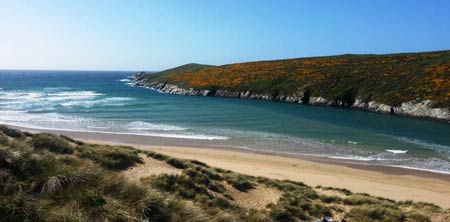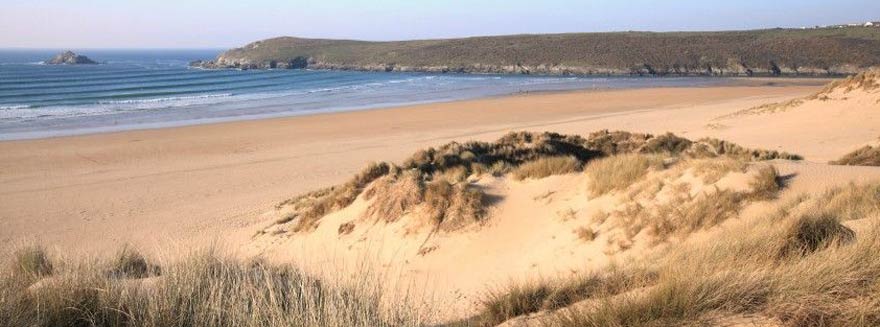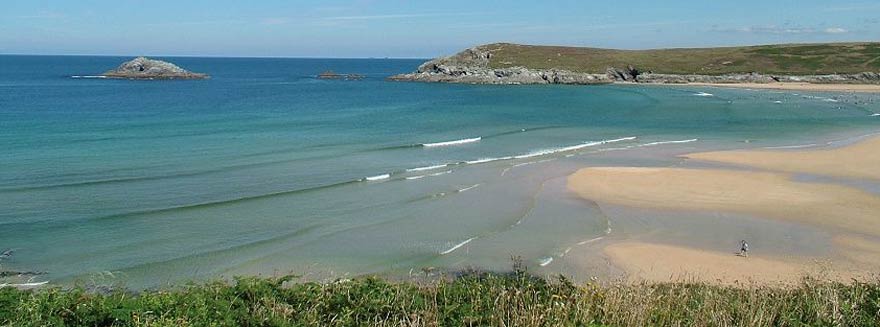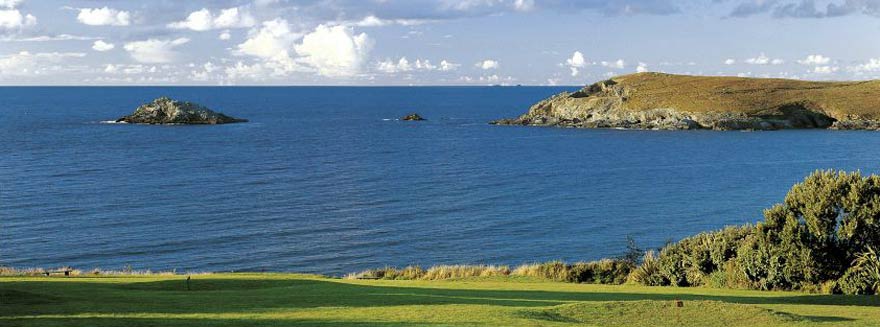
Facilities
The beach has a range of facilities, including
cafes, surf hire, toilets and parking.
The Fern Pit Café lies just below
the East Pentire Headland ( on the Eastern banks of the River
Gannel - just across from the main beach). The picturesque Café
and Boathouse has some stunning views of both the beach
and the river. The café provides a range of sandwiches and light
refreshments, as well as their own locally caught lobster and
crab. Adjacent to the Fern Pit café is a small path leading to
the Ferry - a small boat that runs across the river from
East Pentire to Crantock Beach at high tide, when the
small footbridge is not available.
On the main beach at Crantock, there is a small
kiosk located at the River Gannel end of Crantock Beach . The
Crantock Beach Kiosk operates during peak season,
supplying a range of snacks, andwiches, beverages, ice creams,
hot and cold drinks. Windbreaks, sun loungers, deckchairs, and
sun parasols are also available to hire from the kiosk.
Surf Hire, (surf boards and wetsuits)
is also available at the beach from a converted shipping container
-located on the beach, at the edge of the sand dunes, just a little
way down from the kiosk.
Dogs are allowed on Crantock Beach all
year round
Parking at Crantock Beach
National Trust car parking (free to NT
members) is available in Crantock village as well as
a private overflow carpark. From the NT car Park in Crantock village
there is a level route to the beach, which is signposted. Pay
and Display Parking is also available at the end of both West
and East Pentire Headlands.
River Gannel Ferry - East Pentire (Newquay)
to Crantock Beach
During the summer the Fern Pit café runs a a regular
ferry service between Crantock Beach and East Pentire headland,
Newquay. The ferry service is available 3hours either side of
high water. A small ferry boat (the 'Sunshine') will take people
across the short stretch of river from East Pentire to Crantock
a distance of about 200 yds - ( a small charge applies). At low
tide, there is a small foot bridge which people can use free of
charge.
Porth Joke Beach
Porthjoke, or Polly Joke, is a
secluded sandy beach located in a narrow cove between the West
Pentire and Kelsey Headlands- between its two well known neighbours,
Holywell Bay and Crantock Bay.
Polly Joke is a small sandy beach is a quiet
location, with no facilities or toilets. Access is via a footpath.
Parking at porth Joke is limited, so the car parks at West Pentire
are strongly recommended, requiring a walk to Porth joke of just
under a mile. Polly Joke. This delightful cove, entirely surrounded
by National Trust land and virtually unchanged over the
centuries, obtained its name from the old Cornish words for 'Jackdaw
Cove' ....'Pol-Lejouack'. The jackdaws are still there!
Crantock Village
Crantock's long history has made it a place of
visual delight and rural charm, but it has much to offer today's
visitor - not least the warm welcome you will receive - but there
are also art and craft shops, a tea garden, restaurants, pubs,
one of the most beautiful beaches on the north Cornish coast and
miles and miles of wonderful paths along which you may walk in
almost any direction.
The village of Crantock retains much of
its original old fashioned charm and character. Large
parts of the local parish are now in the ownership of the National
Trust, including West Pentire headland which is now a Site of
Special Scientific Interest - noted for its wonderful wild flowers
and rare plants. The famous South West Coast Path follows the
seaward side of the parish - along the edge of Crantock Bay and
around West Pentire towards Holywell Bay. The
older part of the village is situated around its church which
is dedicated to St Carantoc, founder of the village. Crantock
developed as a little hamlet, hidden from the sea by the sand
dunes of Crantock Bay. Originally the village was known as Langurroc
- 'The Dwelling of Monks'. The small isolated community dates
back to 460 AD and was a major centre of religious activity before
the Norman conquest and had its origins in the arrival of one
of the Sixth Century Welsh Celtic saints ... Carantoc.
The name 'Crantock' is thought to be a corruption of the name
of Carantoc.
Legend has it that, when Carantoc, first arrived
in the Gannel Estuary, he quickly realised that the bay offered
a sheltered haven from the wrath of the sea on the north coast.
Carantoc decided to build himself an oratory near to this sheltered
location. However the dove that he had brought with him had other
ideas and, picking tip a twig, flew inland a little way and then
dropped the twig. Carantoc took this as a sign as to where to
build his oratory and, in the passage of time, this grew to be
of considerable stature and, by the Survey of 1294, the religious
college enjoyed great revenues. The College at Crantock suffered
at the Dissolution of the Monasteries by Henry VIII, but the Norman
St Carantoc's Church survived and, although suffering
neglect over the centuries, was reconstructed in the 14th and
15th centuries and fully restored E. H. Sedding in 1899-1902.
at the turn of the twentieth century and now boasts some of the
finest wood carving in the West Country.
In the centre of the village is the Round
Garden, now owned by the National Trust, but almost certainly
the site of one of the seven Celtic chapels that would have surrounded
the original church. The Round Garden, is in
fact an orchard and one can sit there and enjoy the peace of this
ancient place. Nearby is the village well - one of many in the
parish - and opposite the village green is the little Memorial
Hall, built to commemorate those who died in the two World Wars
and which is now used for village events. Alongside are some of
the picturesque thatched cottages and Water lane that leads to
two of the village inns - one the ancient thatched Old
Albion Inn, notorious as a centre for smuggling.
|







